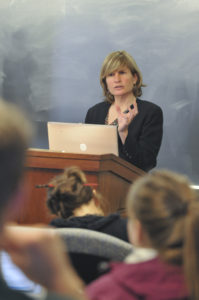Monthly Archives: November 2020
Nov 16, 2020 Anna GelpernCorporate Law
Fifteen years ago, U.S. legal scholarship treated central banks like the neglected stepchildren of bank regulation and administrative law: hardly anyone wrote about them, and no one who did not work for them seemed to care. The financial crisis that began in 2007 put the Federal Reserve, the Bank of England, and the European Central Bank in the middle of national and global crisis response strategies, and instantly made central banks the center of attention in a rich and fast-growing legal literature that continues to attract exciting new scholars.
Nonetheless, ceding central banks to economists for so long turned out to be costly: lawyers have spent much of the last decade fleshing out the underlying assumptions and basic terms of the debate, and deciding whether and how to assimilate economists’ theories of central banking into their own. The foundational question of distribution—how central banks’ monetary policy and financial stability activities distribute resources and allocate losses from crises among constituents—has lingered especially awkwardly over this area.
The slightly-stylized standard view associates distribution with fiscal policy, politics and legislatures. In this view, monetary and financial stability policies of the sort conducted by central banks do not distribute: they are for everyone at once, no one in particular, and best left to independent technocrats. This standard view is increasingly at odds with public perceptions of central banks as purveyors of bailouts for the few and peanuts for the rest. The disjunction can become a big political problem, freshly salient in the face of the multi-trillion-dollar response to the COVID-19 pandemic. The pandemic response again put central banks at the center, and took me back to Nadav Orian Peer’s pre-pandemic article situating the Federal Reserve at the intersection of political battles over corporate concentration, regional and sectoral development and, of course, money. Continue reading "Central Banks’ Distribution, Revisited"
Nov 13, 2020 Elizabeth JohCriminal Law
Stephen Rushin & Roger Michalski,
Police Funding, 72
Fla. L. Rev. 1 (2020).
For eight minutes and forty-six seconds, Derek Chauvin pinned George Floyd’s neck to the ground outside of the Minneapolis Cup Foods on Chicago Avenue. Floyd’s shocking death, captured on a bystander’s cellphone video, led to criminal charges against Chauvin and the three other officers involved in the arrest. Floyd’s death also catalyzed thousands of protests around the United States and the world, and to the rallying cry of “defund the police.” These three words are memorable, but what do they mean? It depends whom you ask. For some, “defund the police” means reallocating some of the non-criminal duties that have become the responsibility of the police–think of outreach to the homeless and the mentally ill–to other non-police community service providers. For others, it is less a literal command and more a call to reimagine the objectives of street policing. And for some, it is indeed about police abolition.
But if we take these calls seriously and literally, they aim to reduce police department budgets as a method of reform. Unlike close analyses of the Fourth Amendment or legislative responses, police budgets usually escape the attention of legal scholarship. But in Police Funding, Stephen Rushin and Roger Michalski have presciently raised this issue as a topic of serious study. Police reform advocates calling for “defunding the police” should pay attention to the important observations the authors raise in their timely article. And one of the article’s central arguments is especially relevant after George Floyd’s death: that adequate funding should be seen as a prerequisite for accountable, democratic, and professional policing. Continue reading "What If “Defunding The Police” Makes Policing Worse?"
Nov 12, 2020 Marin K. LevyCourts Law
The field of judicial administration has started to produce an embarrassment of riches. Many of the legal academy’s best young scholars are taking up critical issues related to how courts operate and how judges reach their decisions. Two forthcoming articles (and their authors), which take on the topic of non-binding authority, are perfect exemplars: Maggie Gardner’s Dangerous Citations and Merritt E. McAlister’s Missing Decisions.
As we know, courts cite to binding precedent in their opinions to support a particular point (e.g., the law on X is Y in Z jurisdiction). There are times, however, when courts cite to non-binding precedent, be it a published opinion from a court that cannot bind it or an unpublished opinion that binds no court. And we generally have assumptions about how this process works. First, that courts cite to non-binding authority sparingly and only when truly appropriate (e.g., for a persuasive point that is not well captured elsewhere). Second, that all decisions that a court might cite—including unpublished ones—can easily be accessed and assessed by the public. Gardner and McAlister challenge these assumptions in their respective articles. Continue reading "The Status of Non-Binding Authority"
Nov 11, 2020 Jill FamilyLexImmigration
The Law of Rescue connects aiding migrants to the body of law governing rescue generally. Professor Shalini Bhargava Ray proposes a new theoretical framework for the law of rescue based on her examination of prosecutions for migrant rescue. Her framework de-emphasizes economic interests and lifts up considerations of liberty and dignity.
While “[t]he law of rescue was not designed to express, promote, or protect the human dignity of beneficiaries or the liberty of rescuers,” (P. 623) Professor Ray argues that it should be redesigned to do so. Her new framework would balance three considerations: (1) the rescuer’s liberty to engage in the rescue; (2) the beneficiary’s need for rescue; and (3) the potential third-party harm flowing from a consensual rescue. Continue reading "Rescue Based in Liberty and Dignity"
Nov 10, 2020 Eyal ZamirContracts
David A. Hoffman and Cathy Hwang,
The Social Cost of Contract, __
Columbia L. Rev. __ (forthcoming), available at
SSRN.
Almost ninety years ago, Morris Cohen taught us that the primary role of contract law is to place the enforcement mechanism of the state at the service of one party against the other (Cohen 1933, Pp. 585–86; see also Zamir 1997, Pp. 1777–78). Since enforcement of contracts entails the exercise of governmental powers and the use of public resources, contract law (like the rest of private law) is part of public law. This means that whatever the role played by freedom of contract, it cannot be the only principle that motivates the law. Contract law inevitably reflects public concerns, as well. Most obviously, it follows that whenever a contract creates substantial negative externalities—that is, whenever it adversely affects the well-being of other people—there are prima-facie grounds for curtailing freedom of contract (Zamir & Ayres 2020, Sec. 1.A). Examples of doctrines that serve this goal include the rules concerning illegal contracts, contracts against public policy, and various other mandatory rules.
As in past epidemics, COVID-19 creates situations in which the performance of contracts might adversely affect the public at large. These include contracts pertaining to events with many participants—such as weddings, funerals, and conferences—which may turn into super-spreading events. It also includes more mundane contracts, such as between universities and students, since attending ordinary classes may also result in spreading the disease. Performing such contracts may or may not be forbidden by law. Either way, one of the parties (typically, but not invariably, the customer) may wish to back out of it—in which case a legal dispute may arise. How should such disputes be resolved? What should we advise the parties to do in such circumstances? These questions lie at the heart of David Hoffman’s and Cathy Hwang’s highly recommended article, The Social Cost of Contract. Continue reading "Contracts in the Time of COVID-19"
Nov 9, 2020 Helen NortonConstitutional Law
The term “reproductive health care” encompasses safe access to gynecologic and obstetric care, prenatal care, the prevention of sexually transmissible disease, contraception, and abortion. The term “reproductive health care exceptionalism” refers to the ways in which law and medicine frequently single out reproductive health care services, particularly contraception and abortion, for different and disadvantaged treatment. In Essentially Elective: The Law and Ideology of Restricting Abortion During the Covid-19 Pandemic, Jessie Hill builds on her thoughtful and important body of work on reproductive health care exceptionalism—and its impact on women’s lives.
Examples of reproductive health care exceptionalism include the special Due Process Clause rules that the Supreme Court applies to the government’s regulation of abortion. Normally, courts apply strict scrutiny to the government’s restriction of a fundamental right; this requires the government to show that its choice is narrowly tailored to serve a compelling government interest, a burden that the government rarely meets. But while Planned Parenthood of Southeastern Pennsylvania v. Casey purported to reaffirm Roe v. Wade‘s holding that a woman’s decision about whether to have an abortion is a fundamental right protected by the Due Process Clause, the Casey Court nevertheless applied a new, more government-friendly, test to the government’s regulation of abortion. More specifically, Casey announced the “undue burden” test for assessing the government’s restrictions on abortion, a test that is much more forgiving of the government than strict scrutiny—and a test with contours and applications that remain deeply contested, as most recently illustrated by the Court’s fractured opinions in June Medical Services, LLC v. Russo. Continue reading "Reproductive Health Care Exceptionalism and the Pandemic"
Nov 6, 2020 Mila SohoniAdministrative Law
Kathryn E. Kovacs,
Constraining the Statutory President, __
Wash. U. L. Rev. __ (forthcoming), available at
SSRN.
There’s a legal black hole at 1600 Pennsylvania Avenue where there shouldn’t be—or so argues Professor Kathryn Kovacs in a spirited new article, Constraining the Statutory President. A “legal black hole,” as Adrian Vermeule defined it, exists when statutes or legal rules create a zone in which the rule of law, including the constraints of administrative procedure and the checks of judicial review, cannot penetrate. And, as Vermeule pointed out, the Court created just such a black hole in Franklin v. Massachusetts by flatly excluding the President from the ambit of the Administrative Procedure Act: “the President is not an agency within the meaning of the APA.” Franklin is probably not what most people would call a “fixed star in our constitutional constellation.” But it is now a fixed “black hole” in the (administrative) constitution—a holding subsequently reaffirmed by the Court, abided by lower courts, left undisturbed by Congress, and treated as a given by many scholars.
Kovacs dissents from this acceptance of Franklin. Her article is one of a noteworthy set of recent articles that have examined presidential power and the constraints that should be imposed upon it. This boomlet of scholarship has addressed, among other topics, frameworks for judicial review of presidential orders, the importance of presidential fact finding, and the internal White House process of crafting presidential proclamations, directives, and orders. Speaking on a more conceptual plane, one new article offers a comprehensive defense of the thesis that the “duality” of the Presidency—i.e., that the President is both a mortal man and a public office—is a “defining ambiguity” of public law. Continue reading "Administrative Law All the Way Up"
Nov 5, 2020 Martin H. MalinWork Law
David Horton,
The Arbitration Rules: Procedural Rulemaking by Arbitration Providers, 105
Minn. L. Rev. __ (forthcoming), available at
SSRN.
In the ongoing discussion over so-called mandatory arbitration “agreements” imposed on consumers and employees, many have focused on questions of fairness and justice, on the potential of such privatization of adjudication to stifle development of the law, on whether mandatory arbitration amounts to suppression of low-dollar-value claims, and on whether arbitrators are overtly or implicitly biased in favor of businesses and employers who as repeat players are the sources for future work for the arbitrators. Largely missing from the discussion are the arbitration services organizations, such as the American Arbitration Association and JAMS. In The Arbitration Rules: Procedural Rulemaking by Arbitration Providers, David Horton goes a long way to filling that void.
Horton begins with a useful report on the history and evolution of arbitration services organization rules. The heart of the article is his analysis of the rules on three grounds, based on a comparison of the arbitration rules to the Federal Rules of Civil Procedure. Continue reading "Focusing on an Often-Neglected Player in the Mandatory Arbitration Game"
Nov 4, 2020 John C.P. GoldbergTorts
Unlike its counterpart at the local IHOP®, the menu of standard tort remedies makes for a quick read. There are damages (in several ‘flavors’), injunctions (typically ordering a halt to tortious activity), declaratory judgments, and … that’s about it. In her fascinating and provocative article The Knowledge Remedy, Alexandra Lahav advocates for a new item to be included in the injunctions portion of the menu. In certain toxic tort cases, she maintains, courts can and should order a defendant to cover the cost of independent research designed to determine whether a substance for which it is responsible is capable of causing the type of injury for which the plaintiff is suing.
Lahav’s opening example, based on an actual case, conveys the basic idea. A farmer notices that his once healthy livestock are dying, as are some local, furry woodland creatures. The farmer has his suspicions. It was not so long ago that a nearby factory commenced operations, and it was only a little after that that the creek that runs through the farm, and from which the critters drink, began to foam up in an odd way. And so the farmer hires a lawyer, who sues the factory’s owner for private nuisance and obtains evidence that the factory has been dumping into the creek a chemical compound that was never vetted for safety by the EPA. Eventually, the litigation settles. In addition to agreeing to install filters, the owner agrees to fund scientific studies to determine what sorts of illnesses in animals and humans the compound is capable of causing. Continue reading "Remedies as a Remedy for Uncertainty"
Nov 3, 2020 Aníbal Rosario-LebrónFamily Law
Kaiponanea T. Matsumura,
Breaking Down Status, 89
Wash. U. L. Rev. __ (forthcoming Jan. 2021), available at
SSRN.
The COVID-19 pandemic has highlighted the precarity in which millions of people live in the United States. In his forthcoming article, Breaking Down Status, Kaiponanea T. Matsumura shows us how this precarity is intrinsically linked to the law’s inevitable (or perhaps willful) insistence on regulating important social, economic, and personal relationships through a status-based regulatory system. To discuss the obsolescence and ineffectiveness of this scheme and how it should be reformed to one in which status is defined independently from contract and adapted to the current social and legal landscape, Matsumura uses as a case study two statuses that are seldom thought today to be interrelated: worker classification and marital status.
This approach in and of itself is a great contribution to the scholarship of status. By taking this viewpoint, Matsumura is able to survey the typology of status. While dissecting the taxonomy of status, he establishes how the concept has been applied interchangeably to refer to interrelated legal and non-legal phenomena. This ambiguity has obscured the scholarly discussions about status-based regulation by selectively focusing on one of its aspects. As laid out in the article, this selective approach can be seen best in the social normative vis a vis legal effects critiques to Obergefell. Continue reading "Rounding the Square Peg: Matsumura’s Redefining of Status Regulatory Schemes"















